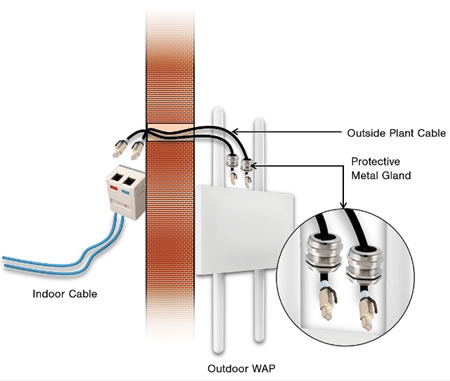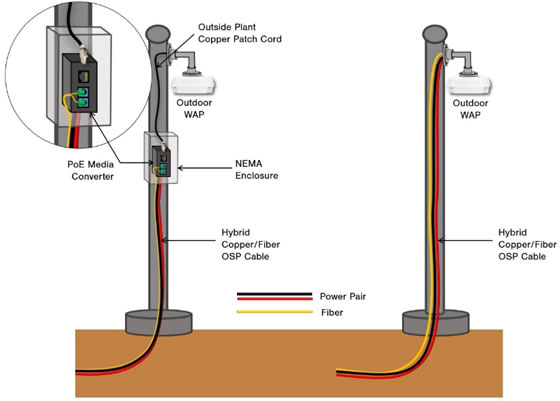Need Outdoor Wi-Fi? What You Need to Know
Filed under: WiFi
Comments: Comments Off on Need Outdoor Wi-Fi? What You Need to Know


Wi-Fi is now ubiquitous across all environments and vertical markets, and the demand for outdoor wireless access has increased significantly. Whether it’s a university, amusement park, stadium or resort, many enterprise businesses need to now deploy outdoor Wi-Fi to keep up with the demand. But there are some key considerations—not only must the wireless access points (WAPs) be outdoor rated to withstand the rigors of outside environments, but cables and connectivity also need to be protected from the elements. And then there’s the question of how best to deliver power, as well as other considerations like grounding, interference, throughput, coverage and security.
Let’s take a look at the various considerations for deploying outdoor WAPs mounted on the building exterior, poles or other external structures.
Cable Considerations
Indoor/outdoor cable can be used to connect outdoor WAPs mounted to the exterior of a building to networks installed within a building. However, if the WAP is mounted on a pole or other separate external structure that requires the cable to be deployed in a direct burial, lashed aerial or underground conduit application, the cable can be subjected to moisture, temperature extremes and/or UV radiation. This requires the use of outside plant (OSP) cable that must be installed within conduit or transitioned to indoor cable at the building entrance.
Distance is another consideration when it comes to selecting cable for your outdoor WAPs. Twisted-pair copper cable is limited to 100 meters per industry standards, but if the WAP is located further away, you’ll need to use optical fiber cable that can extend well beyond 100 meters (up to 10 km in fact, depending on the fiber type).
Connection Protection

Not only must the cable be protected from the elements, but so should the actual plugs and outlets. A WAP may have built-in weather-proof conduit that protects both the incoming cable and plug. Others may have a protective outlet that requires the use of a ruggedized plug with chemical-resistant thermoplastic plug housing and a quarter-turn bayonet-style mating to ensure an IP66/IP67-rated seal.
Also common with outdoor WAPs is the use of a protective metal gland that slides over the network cable before the cable is terminated to a plug. After the cable is plugged into the WAP, the metal gland is screwed into place on the WAP. Protective metal glands are ideal for use with field-terminated RJ45 plugs, but you want to make sure that the plug you choose is small enough to fit within the gland when it is mated.
Siemon’s Z-PLUG is the smallest field-terminated plug on the market—click HERE to read about its use with the protective metal gland for outdoor WAPs and the University of South Carolina.
Power and Grounding
Outdoor WAPs are often mounted nowhere near a local power source, but if local power cannot be provided or is cost prohibitive, you still need a way to power your WAP. Ideally your WAP supports Power over Ethernet (PoE) and can draw DCc power directly through the same copper cabling that connects it to the network. For PoE applications, and for general interference protection, shielded twisted-pair cabling is recommended. This will ensure a lower temperature rise when power is applied over the cable, which can especially be a concern in direct sunlight and warmer climates.

But what about extended distance scenarios where the WAP is connected via fiber optic cable that doesn’t have the ability to deliver PoE? That’s where hybrid power/fiber cable can be an ideal solution. Featuring a duplex fiber for data transmission along with insulated various gauges of copper conductors for power all within a single jacket, these cables can connect directly to devices that include a fiber port for data and power terminals for power. If the WAP doesn’t have a fiber data port, the hybrid cable can terminate to a PoE media converter placed in an outdoor-rated NEMA enclosure, which converts the optical signal and delivers both a data and PoE connection to the WAP using a copper patch cord.
You also need to consider lightning strikes, and outdoor WAPs should be properly grounded to prevent damage. Depending on the location and size of the WAP, it may need to be grounded to the mounting structure and the structure itself may need to be equipped with lightning protection. Surge protection should also be considered, and most PoE-enabled outdoor WAPs feature built-in dedicated surge protection to isolate and protect any inside network equipment. It’s important to refer to your WAP manufacturer’s guidelines for grounding.
Throughput Requirements
Wi-Fi 6 (IEEE 802.11ax) is the latest Wi-Fi standard capable of achieving greater than 5 Gb/s throughput, up from Wi-Fi 5 (IEEE 802.11ac) at 1.3 Gb/s. For both Wi-Fi 5 and Wi-Fi 6, industry standards recommend a minimum of 10 Gb/s capable balanced twisted-pair copper or optical fiber. The standards also recognize that the use of multiple horizontal links to a single WAP (link aggregation) may be required to support current and emerging WAP technologies. The primary requirements to meet the throughput for today’s Wi-Fi are as follows:
- A category 6A/class EA connection is the only way to guarantee support for 1.3 Gb/s throughput for Wi-Fi 5 Wave 1 WAPs.
- Two category 6A/class EA connections are the only way to support management, redundancy and link aggregation needed to achieve greater than 5 Gb/s throughput for Wi-Fi 6 Wave 1 WAPs, while ensuring support for greater than 10 Gb/s for future Wi-Fi deployments.
- A minimum 25 Gb/s capable fiber backbone is recommended to support Wi-Fi 5 and Wi-Fi 6 uplink capacity.
Additional Considerations
Not only should you follow your WAP manufacturer’s recommended installation instructions and industry standards, but you also want to make sure you have ample coverage. This depends on the amount of space you want to cover, obstacles, mounting location and the range of your WAP antennas.
When mounting your WAP, you may also want to consider security. It should be mounted high enough to keep people from tampering with or defacing the device, but in outdoor deployments you also want to make sure it is securely mounted to keep it from being dislodged by wind or other elements.
To learn more about Wi-Fi applications and deployment considerations, click HERE to download our free Wi-Fi Application & Product Guide.
